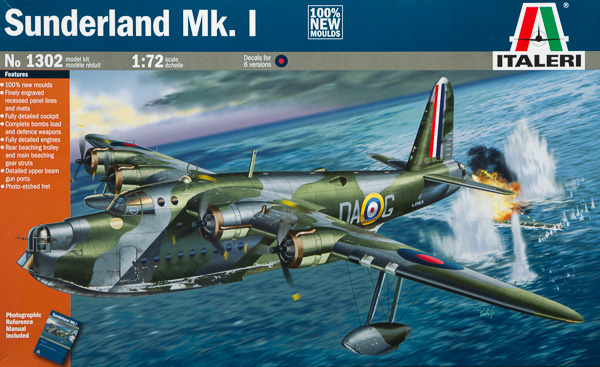
Italeri 1/72 Short Sunderland Mk. I
By Chris Banyai-Riepl
Overview
One of the most famous flying boats of the Second World War, the Short Sunderland entered service shortly before hostilities broke out, in 1938. The Sunderland was a sturdy aircraft, powered by four Bristol Pegasus engines rated at over 1000hp each. With its deep hull and stable flying characteristics, the Sunderland became an excellent aerial platform fighting against the German U-boats in the Atlantic.
The Kit
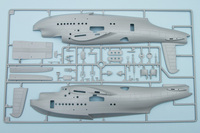 This is not the first kit of the Sunderland to arrive in 1/72, as Airfix had done one ages ago. However, that was a Sunderland Mk V, while Italeri has chosen to release the earlier Mk I variant. There are differences, mainly in the hull, so having a variant to complement the existing kit is quite nice to have. The Italeri kit is molded in gray plastic, with recessed panel lines throughout. The detailing inside and out is quite good, with a decent interior, photetch details, plenty of clear parts, and decals for six options.
This is not the first kit of the Sunderland to arrive in 1/72, as Airfix had done one ages ago. However, that was a Sunderland Mk V, while Italeri has chosen to release the earlier Mk I variant. There are differences, mainly in the hull, so having a variant to complement the existing kit is quite nice to have. The Italeri kit is molded in gray plastic, with recessed panel lines throughout. The detailing inside and out is quite good, with a decent interior, photetch details, plenty of clear parts, and decals for six options.
Construction begins with the interior, and here we have a decent enough cockpit, with photoetch and/or decal instrument panel, seats with photoetch belts, separate rudder pedals, detailed control yokes, and a nice navigator's station complete with table and seat. This assembly then fits onto the lower deck, which has a separate set of stairs, an anchor with rope, and another bulkhead. This assembly fits into the nose of the fuselage, and behind it goes another interior assembly that is centered around the underwing depth charge racks. Throughout this assembly process there are lots of small round windows to add into those halves.
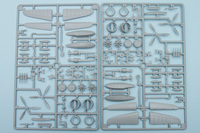 Back to the front end, the next assembly is the nose turret. This is well done, with thin clear parts and plenty of detailing. As this is a prominent part of the finished kit, the extra detailing here will pay off. As the assembly is similar, the instructions have you build up the rear turret as well. Both of these then get trapped between the fuselage halves, along with the rudder.
Back to the front end, the next assembly is the nose turret. This is well done, with thin clear parts and plenty of detailing. As this is a prominent part of the finished kit, the extra detailing here will pay off. As the assembly is similar, the instructions have you build up the rear turret as well. Both of these then get trapped between the fuselage halves, along with the rudder.
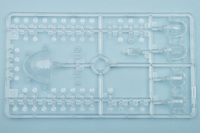 The fuselage assembly is the most complex in this kit, and the build from here on out is pretty straightforward. The wings are split traditionally into upper and lower halves and feature separate ailerons. The kit includes detailed depth charge/bomb racks, and a set of bombs are included. As this is a flying boat, it is designed to sit on the water. This is a problem for us modelers, as we tend to be more of a dry land group. To answer that, this kit provides beaching gear, which is well done. The engines feature separate front cowl rings, separate exhaust pipes, and separate intake scoops, along with propellers with separate hubs. Lots of separate parts here, but the end result will be a good looking engine to stick on the wing.
The fuselage assembly is the most complex in this kit, and the build from here on out is pretty straightforward. The wings are split traditionally into upper and lower halves and feature separate ailerons. The kit includes detailed depth charge/bomb racks, and a set of bombs are included. As this is a flying boat, it is designed to sit on the water. This is a problem for us modelers, as we tend to be more of a dry land group. To answer that, this kit provides beaching gear, which is well done. The engines feature separate front cowl rings, separate exhaust pipes, and separate intake scoops, along with propellers with separate hubs. Lots of separate parts here, but the end result will be a good looking engine to stick on the wing.
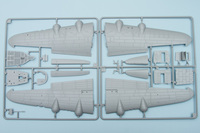 With the bulk of the assembly done, the rest of the build comes in the form of detail parts. There are separate control horns for the ailerons, and several small aerials along the fuselage. The side guns come complete with separate detail parts for the fold-out hatches. The wingtip floats are simple, and the instructions provide information on how to rig them properly.
With the bulk of the assembly done, the rest of the build comes in the form of detail parts. There are separate control horns for the ailerons, and several small aerials along the fuselage. The side guns come complete with separate detail parts for the fold-out hatches. The wingtip floats are simple, and the instructions provide information on how to rig them properly.
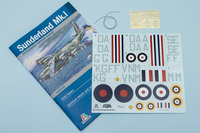 With the build done, attention can turn towards painting. As this is a Sunderland Mk. I, the marking choices are a bit limited over what you might expect for a Coastal Command aircraft. Basically, these will all be fully camouflaged down to the hull bottom, so if you are looking for a white-bellied Sunderland, you'd best look to the Airfix kit (that was a later camouflage scheme). Two of the options are camouflaged in Dark Earth and Dark Green on the upper surfaces, while the rest are in Extra Dark Sea Gray and Slate Gray. Three have Aluminum undersides, one has Medium Gray undersides, one in black, and one in Sky. The rest of the differences come in the fuselage codes. For details on the specific aircraft, you get two from 210 Squadron at Oban, Scotland, two from 230 Squadron in the Eastern Mediterranean, one from 204 Squadron in Bathurst, Gambia, and on from 95 Squadron at Freetown, Sierra Leone.
With the build done, attention can turn towards painting. As this is a Sunderland Mk. I, the marking choices are a bit limited over what you might expect for a Coastal Command aircraft. Basically, these will all be fully camouflaged down to the hull bottom, so if you are looking for a white-bellied Sunderland, you'd best look to the Airfix kit (that was a later camouflage scheme). Two of the options are camouflaged in Dark Earth and Dark Green on the upper surfaces, while the rest are in Extra Dark Sea Gray and Slate Gray. Three have Aluminum undersides, one has Medium Gray undersides, one in black, and one in Sky. The rest of the differences come in the fuselage codes. For details on the specific aircraft, you get two from 210 Squadron at Oban, Scotland, two from 230 Squadron in the Eastern Mediterranean, one from 204 Squadron in Bathurst, Gambia, and on from 95 Squadron at Freetown, Sierra Leone.
Conclusion
This is a nice addition to the Italeri line, and for those wanting a Sunderland but didn't want to tackle the old Airfix kit, here's a nice new tool one to sink your teeth into. My thanks to MRC for the review sample.
